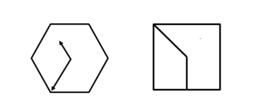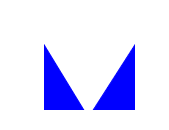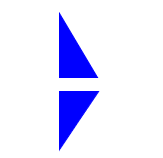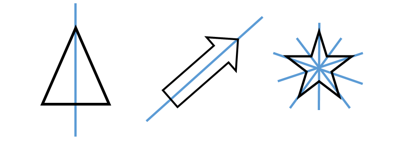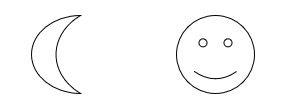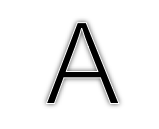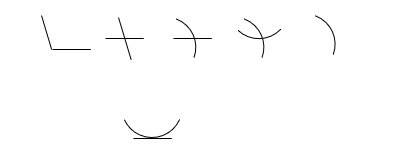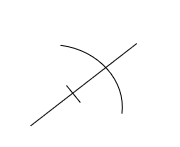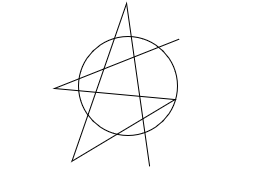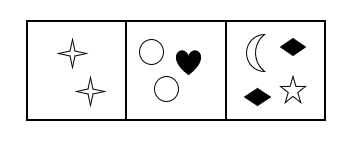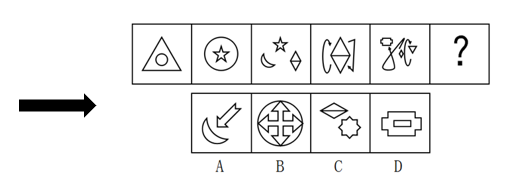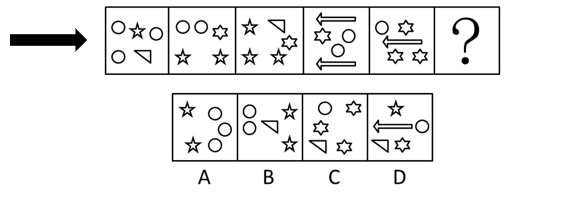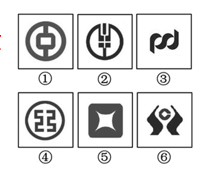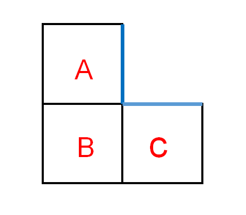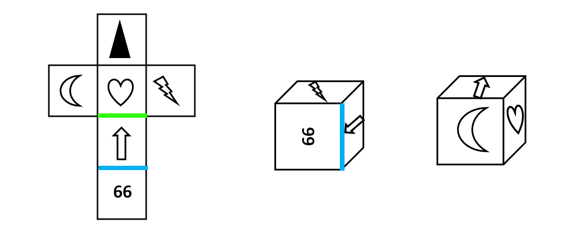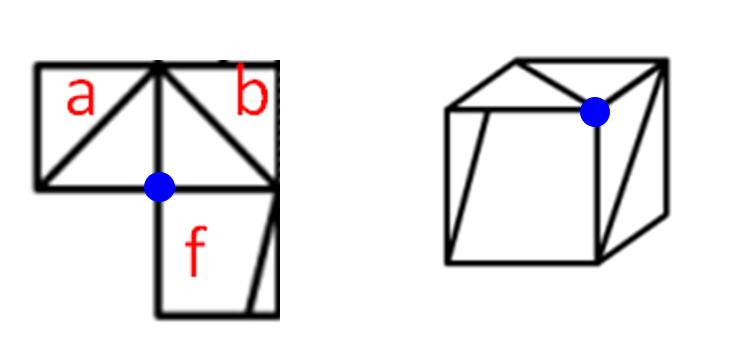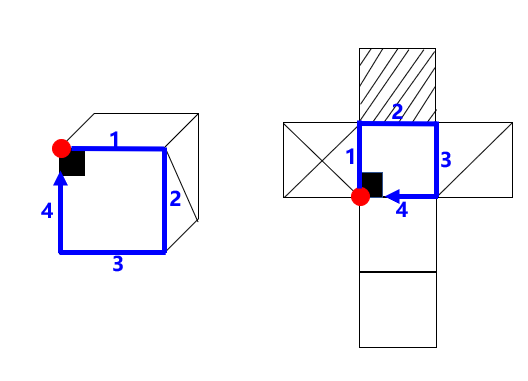
Position Patterns
1. Identify FeaturesAll elements of the figures are composed the same.
2. Exam Points
Exam Point 1: Translation
1. Direction: Straight line (up and down, left and right, diagonal), circular (clockwise / counterclockwise)
2. Steps: Constant, Incremental (Arithmetic)
(1) Problem-Solving Strategies
1. View multiple elements separately, eliminate as you go
2. Position patterns — proximity principle
(2) Grid-type Black Block Translation
1. Some black blocks may overlap
The main question and most options consist of identical elements, with a few images missing black blocks
The first image in the main question usually has the most black blocks and will not overlap
2. Where do black blocks go after reaching the end?
① Loop: Start from the beginning ② Bounce: Directly bounce back
3. How to distinguish between “twin” black blocks
Proximity assumption
(3) The tricky and challenging “return” path
Question type characteristics:
1. 16-grid pattern black block translation
2. The number of black blocks in the center remains the same, but the color changes: prioritize viewing the “return” shape’s inner and outer circles separately
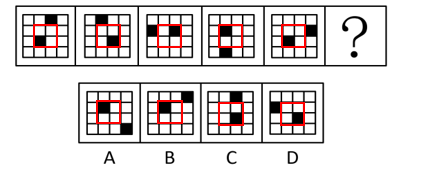
Exam Point 2:Rotation and Flipping
(1) Direction: Clockwise, Counterclockwise
(2) Common angles: 30°, 45°, 60°, 90°, 180°
Lines radiate from the center point in the frame
Don’t get stuck on the length of the lines, focus on the rotation angle
Look at the angles to determine direction
(1) Left-right flip: Vertical axis symmetry
(2) Up-down flip: Horizontal axis symmetry
1. Distinguishing between rotation and flipping
Left-right flip: only left-right interchange (up and down remain unchanged)
Up-down flip: only up-down interchange (left and right remain unchanged)
Rotation 180°: both up-down and left-right interchange
Style Patterns
Similar element composition (lines/elements repeat)
2. Subdivision of Exam Points
Exam Point 1: Traversal — Fill in what’s missing
Traversal question characteristics:
Identical elements repeat (mostly in 3×3 grids and two sets of images)

Exam Point 2: Addition, Subtraction, Same, Different
Characteristics:Same lines repeat
1. Addition and subtraction
2. Finding differences (removing the same)
3. Finding similarities (keeping the same)
Supplement: For position + style questions, which to transform first?
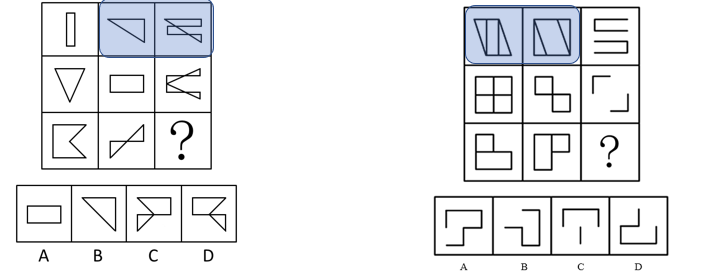
Transform image 1 clockwise by 90°, then find differences with image 2 Image 1 and image 2 find differences first, then transform clockwise/counterclockwise by 90°
Whoever is special, transform first!
1. Image 1 and image 2 have identical lines — do not transform first
2. Image 2 and image 3 have identical lines — transform image 1
3. Image 1 and image 3 have identical lines — transform image 2
Exam Point 3: “Black and White” Operations
1. Characteristics:Shapes and segmented areas are the same, but the internal colors differ
2. Method: Operations at the same position
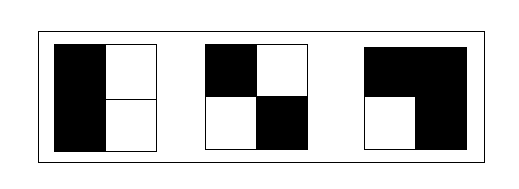
(1) Specific rules for operations should be identified for each question
(2) Black + White does not necessarily equal White + Black; this must be verified with specific questions
Attribute Patterns
1. Characteristics of Attribute Recognition:
Elements are not the same or similar — prioritize attributes

Identifying Features: “Isosceles” elements appear
Identifying Features: Parallelogram, N, Z, S deformed figures appear
(3) Axial Symmetry + Central Symmetry
Identifying Features: Figures have mutually perpendicular axes of symmetry
(1) Direction and number of symmetry axes
(2) Relationship between the symmetry axes and the position of the midline in the figure: Coinciding, perpendicular, parallel
2. Open and Closed Properties
3. Curvature and Straightness
(1) All straight line figures
(3) Curved + Straight figures
Special Patterns
1. Relationship between Figures
Identifying Features: Each figure in the main question appears with two or more closed shapes connected together

(1) Intersecting at points

(2) Intersecting at edges
(3) Intersecting at surfaces
a. Refinement of intersecting at edges

I. Look at the quantity: How many lines
II. Look at the style: Long/short, whole/partial
b. Refinement of intersecting at surfaces

Refining Exam Points: Shape and size of the intersecting surfaces
Black dots, white dots, arrows, small shapes
Marking positions
Identifying Features: Each figure has the same small elements appearing, prioritize functional elements
1. Points: Intersection points
2. Lines: Straight lines/curves, longest line/shortest line
3. Angles: Right angle/sharp angle/obtuse angle, largest angle/smallest angle
4. Surfaces: Overlapping surfaces, largest surface/smallest surface, left/right
Quantity Patterns
Elements are not the same or similar, and attributes have no pattern
Quantity patterns are obvious
Exam Point 1: Number of Points
Intersection points of lines
Note: Intersection points also count as intersection points
(1) Lines crossing obviously (like tree branches)
(2) A messy bunch of intersecting lines
Refinement of Points Method 1: Tangent points
Identifying feature images show point occurrences, but overall point count is irregular, and each image has tangents; consider refining points by counting tangent points
Refinement of Points Method 2: Curved and straight intersection points
Identifying feature images show point occurrences, but overall point count is irregular, and there are curved and straight intersections; consider refining points by counting curved and straight intersection points
Refinement of Points Method 3: Internal and external intersection points
Identifying feature images show point occurrences, but overall point count is irregular, and there are clear framework figures; consider refining points by counting intersection points inside, outside, and on the framework
Exam Point 2: Number of Lines
1. Straight line characteristic images: Polygon, single straight line
2. Curved line characteristic images: Curved figures (circle, arc, single curve)
1. Single stroke: The figure is drawn with a single stroke, and lines cannot be drawn back and forth
2. Determining a single stroke: The following must be met simultaneously
(2) The number of odd points is 0 or 2
Odd points: A point at the center from which an odd number of lines radiate
Note: Endpoints also count as odd points
Stroke count = number of odd points / 2 (the number of odd points must be even)
[Common Characteristic Images of Stroke Counts]
Pentagram; “Sun”, “Field” and their deformations; circles tangent/intersecting; Obvious endpoints appear



Exam Point 3: Number of Surfaces
1. Definition of “surface”:
2. When to count “surfaces”?
(1) The figure is segmented, and the enclosed surfaces are obvious
(2) Everyday figures, figures with thick lines that leave blank areas
3. Refinement of Surfaces Exam Method
· When to think about refinement?
Identifying feature images show surface occurrences, but overall surface count is irregular
· Can refine and observe the shapes of surfaces
a. All shapes of surfaces
b. Number of surfaces with the same shape
c. Shape of the largest/smallest surface
Exam Point 4: Number of Elements
Exam Points: 1. Number of elements
Characteristics: Multiple independent small figures
Summary of Small Element Exam Points
Step 1: Count the number, count the types
I. Find the same between two adjacent figures
II. Find the same within each figure
1. Position of identical elements inside
2. Quantity of identical elements inside
3. Partial count (lines connected together count as one part)

Identifying Features: Everyday figures, black thick line figures
Supplement: What can common everyday figures and black thick line figures test?
Spatial Reconstruction
Exam Point 1: Relative Surfaces
1. Characteristics: Two opposite surfaces can only see one surface
2. Application: Options where a group of opposite surfaces appear simultaneously — exclude
3. How to determine opposite surfaces in the unfolded figure
(1) In the same row or column, separated by one surface
(2) Z-shaped ends — the surfaces adjacent to the Z midline
Exam Point 2: Adjacent Surfaces — Common Edges
How to determine common edges:
1. Common edges of two surfaces directly adjacent in the plane figure
2. Two edges forming a right angle in the plane figure are the same edge
3. In a row of four surfaces, the two edges at both ends are the same edge
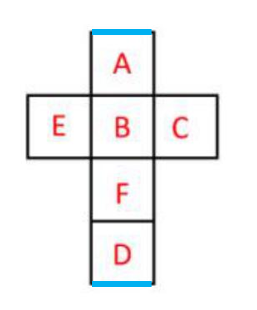
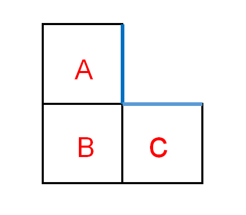
Tips: Look at the relative position (the direction of the figure is obvious)
Note: The relationship between adjacent surfaces remains unchanged before and after folding
Exam Point 2: Adjacent Surfaces — Common Points
Note: The relationship between adjacent surfaces (lines leading from common points) remains unchanged before and after folding
Exam Point 2: Adjacent Surfaces — Edge Drawing Method
1. Combine the options, find a unique point of a special surface
2. Draw edges in a clockwise direction and mark the sequence number
3. Correspond the main question with the options: Exclude where surfaces are inconsistent
Note: The same surface, the same point, the same direction
Supplement: Order of Thinking for Hexahedrons
1. Determine which surfaces are represented in the options — if there’s a surface that appears out of nowhere, exclude it immediately
2. Determine the positional relationship between surfaces
(1) Opposite surfaces appearing simultaneously — exclude
(2) Distinguishing the positional relationship between two surfaces — use the common edge method
(3) Distinguishing the positional relationship between three surfaces — use common points
(4) Special surfaces with unique points — use edge drawing method

Address: 15th Floor, Building 1, Hengxing International City, Nanguan District (Intersection of Jiefang Road and Dajing Road)
Phone: 0431-81349333
Address: 3rd Floor, Building A2, Fudi Carnival Plaza (Next to Jingyue University Town)
Phone: 0431-82041333
Address: No. 111, Jiefang East Road, Changyi District, Chalk Public Examination (Next to Bank of China)
Phone: 0432-63018666







